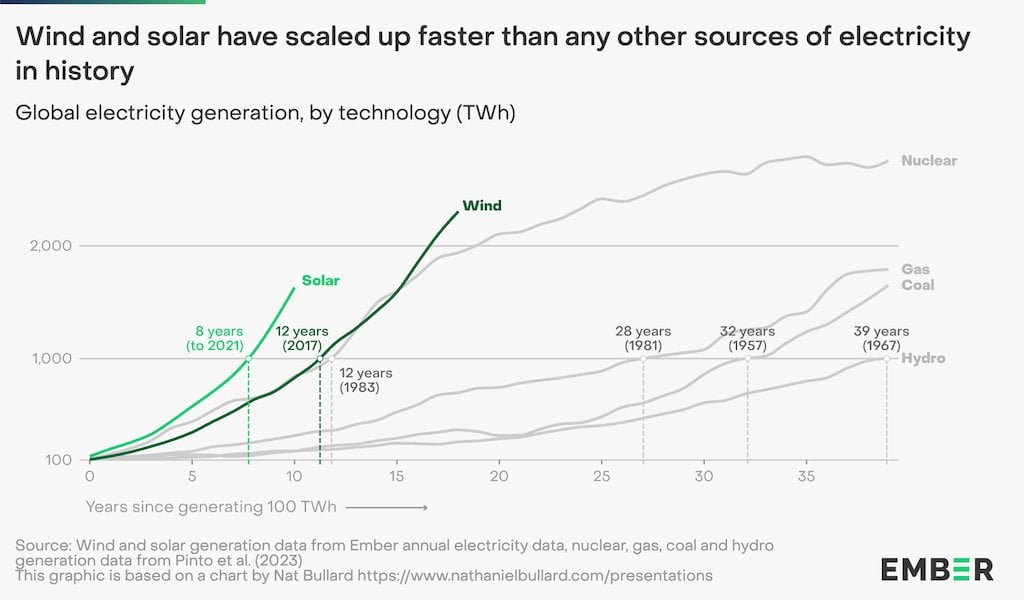Electrify everything says Michael Liebreich of the Cleaning Up Podcast and Lord Adair Turner. In a podcast well worth listening to, both come to the same conclusion. There are not excuses to electrify everything. Both interviewer and interviewee have been working in the climate and renewable energy sector for multiple decades. They recall in the early 2000’s technology solutions seems very expensive and the problem had few solutions. With little hope the climate crisis could be solved cost effectively. Advances in solar PV and batteries with their 20% in cost due to Wright’s Law reduction makes it very doable. The technology at the right price is now available. That so many are sucked into conspiracy theories denying climate science and technology is the challenge facing society. Yet these very same people, sucked into the alternative universe, need to have cheaper, more prosperous and cleaner society.
Era 4 – Renewable Energy

Main Key Points:
- Rebranding and Electricity’s Role:
- The think tank Adair heads up should be rebrandedf to the “Electrify Almost Everything Commission,” reflecting a commitment to increasing electricity in energy systems.
- The Energy Transitions Commission (ETC) predicts electricity could constitute up to 65% of final energy demand, contrasting with the IEA’s highest scenario of 55%.
- Efficiency of Electricity:
- Electrifying all processes to electricity enables 60% reduction in in energy. The emphasis on the efficiency of electricity, particularly through technologies like heat pumps, which can multiply energy output significantly compared to traditional gas boilers.
- We waste energy.
- By it’s very nature, electron-electricity is extremely efficient.
- Primary Energy vs. Energy Services:
- The conversation critiques the primary energy fallacy, highlighting the importance of focusing on energy services delivered rather than energy consumed, which directly correlates with human welfare.
- Technological Progress:
- Rapid advancements and cost reductions in solar PV and battery technology are discussed, with solar PV costs dropping to 9 cents per watt and batteries below $100 per kWh.
- Innovations like perovskites for solar and LFP or sodium batteries for energy storage are highlighted as future game-changers.
- Sector-Specific Developments:
- Solar PV’s democratization, allowing for easy installation by consumers, and its integration with agriculture (agri-PV) for dual land use.
- Wind energy facing challenges due to cost increases from higher interest rates and supply chain issues, but with potential for recovery.
- Nuclear Energy:
- A nuanced discussion on nuclear’s role, suggesting it might be necessary for system resilience despite higher costs, particularly in scenarios where renewable resources are limited or variable.
- Market Design and Policy:
- The need for market reforms like zonal pricing and time-of-day pricing to better align electricity supply with demand, reducing wastage and potentially lowering costs for consumers.
Notable Insights
- Its an optimistic view on the technological evolution in renewables, particularly solar and batteries
- Significant welfare improvements in equatorial and tropical regions.
- Complexity of energy transitions, where even successful technologies like wind face temporary setbacks due to external economic pressures.
- Strong advocacy for policy reforms to harness the benefits of these technologies fully, focusing on how electricity can be managed to serve human needs more efficiently.
Bias
- No explicit misleading information is noted, but there’s a caution about overly optimistic projections for nuclear energy costs, particularly around the assumption of rapid cost reductions with new technologies like small modular reactors. The discussion hints at hidden costs in nuclear projects that might not be accounted for in public cost estimates.
Exciting Technology Improvements
Technology improvements are continuing at pace, and so difficult to see where the technology will end up in 30 years.

Solar PV
- Cost reduction
- Efficiency improvements,
- Verrsatility in use (agri-PV).
Batteries
- Significant cost decreases,
- cheaper materials like sodium
- Enhancing accessibility and utility.
Wind
- Companies got enthusiastic about a large range of systems. Manufacturers need to follow Wrights Law.
- More standardisation needed. Less bespoke systems.
- System construction should be smarter, and less one of a kind in projects.
Nuclear:
Nuclear is a potential complement to renewable energy for system stability but given cost of electricity to consumers is now the most expensive form of electricity.
- Electricity from existing plants are about $60/MWh
- New systems are from $150 up to $300/MWh.
- Extending existing nuclear to more rapidly decrease emissions maybe reasonable.
- Small modular reactors are still some years away
- Existing plants life should be extended for a further 5 years to hasten exit of coal from electricity generation.

More Information
- Have We Lost The Climate Argument? Ep190: Lord Adair Turner Dec 2024 https://www.cleaningup.live/have-we-lost-the-climate-argument-ep190-lord-adair-turner









